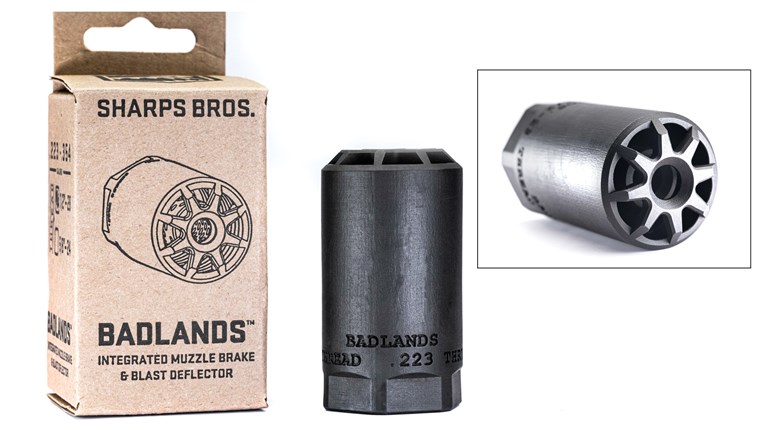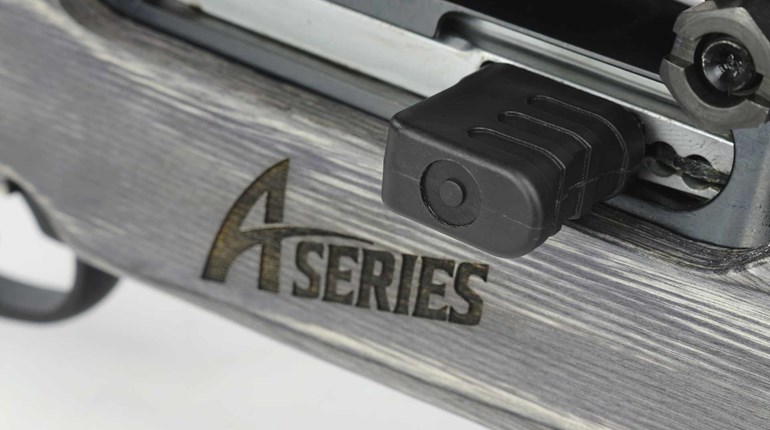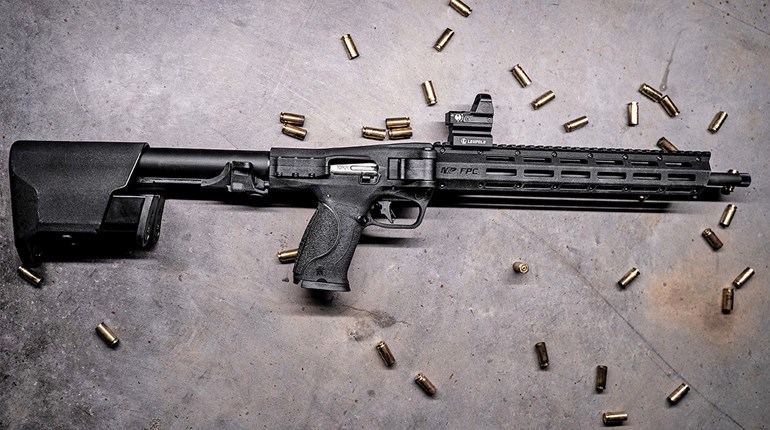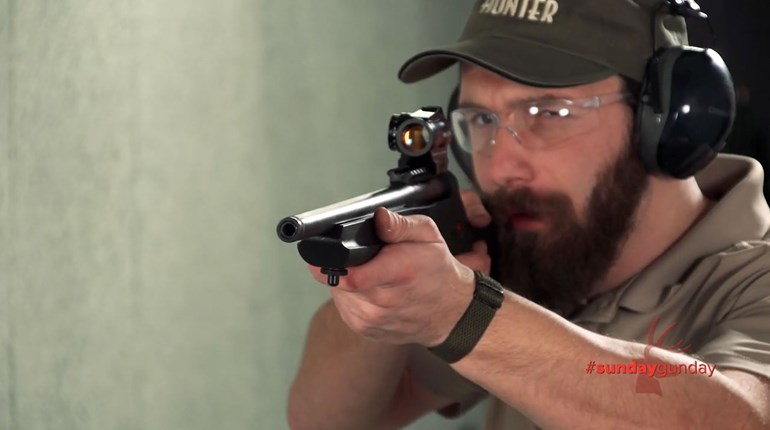
A typical deer hunt is over with a single shot. In the field, we carry rifles a lot more than we shoot them. It's no surprise that some people prefer a single-shot rifle optimized for other qualities—handiness, light weight, accuracy, even style—to ammo capacity and rate of fire. And, in the states where hills and brush limit lines of sight, and where brown deer hides merge with the equally brown ground or late fall foliage, some go with moderately-powered chamberings that are easy on the shoulder and the ear while still sufficing for the game. Taylor's & Co.’s Half-Pint Sharps carbine is an elegant rifle from bygone times; a scaled-down development of the massive Sharps rifles that once brought down American bison herds.

The Sharps falling block action was introduced around 1850. A percussion design, it used combustible paper cartridges, with the bolt wedge shearing the back of the paper to expose black powder to the ignition channel. Unlike most of its contemporaries, it loaded from the breech for greater rate of fire, allowing loading prone behind cover or in motion on horseback. Compared to the Dreyse bolt-action, Sharps provided considerably better obturation in a more compact mechanism. It was slightly slower to operate, being still a percussion rifle with caps handled separately from the cartridge carrying sphero-conical ball and powder.
The massive strength of the falling block allowed very powerful loads exceeding 120 grains of black powder, and excellent accuracy made Sharps a worthy competitor to the muzzleloading Whitworth for sniping. After the Civil War, percussion (and later centerfire) Sharps guns were among the top choices for big-game hunters. With power, accuracy and range combined neatly in one design, quite a few Sharps rifles were bought or later retrofitted with vernier tang peep sights. At the age of 200-yard military rifles, sharpshooters fielding Sharps rifles were a danger to individual soldiers out to 500 yards, and to buffalo even further out.

As centerfire metallic cartridges became more common after the late 1860s, Sharps long rifles and carbines alike proliferated in calibers ranging from the massive .50-90 Sharps and .45-120 Sharps to the more modest—at least by the standards of the day—.45-70 Government. Eventually, Sharps and related the Peabody-Martini lost ground to magazine repeater actions. The only repeating development ever to come from falling block (and even that indirectly) was the 1904 Danish Madsen light machine gun. The large cartridges typical of Sharps rifles became the other factor working against their popularity.
By the end of the 19th century, .45-70 Government or larger calibers gave way to smaller, higher velocity calibers that were easier on the shoulder and budget alike. So the canonical big-bore remained present but uncommon for nearly a century. Cowboy Action Shooting and the movie "Quigley Down Under" gave the Sharps design—now mostly produced by Italian companies like Chiappa—a new chance at popularity. For those who also favor old Western style .44-40 Winchester six-shooters, the Half-Pint Sharps is a stylish and functional medium range companion to the more rapid-fire side arms. For the more utility-minded marksmen, it's a simple and easy-to-use plinker and hunting rifle.
With more young and female shooters entering the ranks of recreational riflemen, it's no surprise that the Half Pint Sharps, reduced about 20 percent linearly and nearly 40 percent by weight, gained considerable popularity. Typical of Taylor's imports, this rifle has good wood to metal fit, and beautiful case-hardened finish on the receiver. Chambered in .44-40 Winchester, a contemporary and rough ballistic counterpart of the more famous .45 Colt, the Taylor’s Half-Pint brought the quaint but efficient manual of arms, along with the accuracy, to a wider audience.
A slightly bottlenecked cartridge capable of 1250 fps with a modern jacketed 200-grain hollow point, it’s loaded to slightly milder 1200 fps by Winchester. It's also available for Cowboy Action Shooting with a 200-grain flat point lead bullet, loaded by Black Hills to very sedate 800 fps. In that form, the .44-40 produces minimal recoil and only a mild report. The slight bottlenecking of the case aids extraction, though at the cost of making the round slightly harder to reload compared to the same .45 Colt.
To load a Sharps carbine, set the hammer at half cock, pull the lever down to drop the breechblock, then load the cartridge straight into the chamber. The process is sometimes frustrated by the weight of the lever pull closing the action slightly, or forcing the extractor back and retracting the loaded cartridge partway out of the chamber, preventing the breechblock from sliding up to close the action. Using the support hand to hold the lever all the way forward removes this annoyance.
In keeping with the long-range reputation of the bigger Sharps guns, this Mini came equipped with a folding Creedmoor tang sight adjustable for elevation. The front of the two double triggers provided emergency short-range release, but the 13 pound pull weight made it impractical for accurate shooting at distance. The similarly heavy curved rear trigger may be pulled first, setting the front to a much more reasonable 2¼ pounds. In test firing, I found that the peep sight opening was small enough to cause some diffraction, and also a considerable reduction in the availability of light—not surprising, as Taylor's rates this sight "for daylight use". The same aperture effect helps focus the front sight nicely.

Unfortunately, even the small aperture closer to the eye did not make this sight as accurate as I had hoped; several good marksmen ended up with 3- to 4-inch groups at 100 yards, with tight clusters of hits and outliers indicating that the limitation wasn't in the mechanical accuracy of the gun itself. The rifle was perfectly good for hitting medium-game or past 100 yards, but the whole configuration of it implied far better accuracy. I also found elevation adjustments frustrating: the frame of the tang sight had unlabeled hashmarks, and adjustments were made by unscrewing the aperture slightly to permit vertical travel. Most of the time, the sight would slide too much upon release with no way to tell where its original position was.
To make the best use of the mechanical accuracy available, I mounted a reproduction of the 19th century 4X Malcolm scope made by Hi-Lux onto the Half-Pint. A thin tube with external windage and elevation adjustment, this scope is a visually correct copy of the late U.S. Civil War scopes, but with much improved optical clarity, thanks to modern production techniques. Zeroed at 25 yards, the scoped rifle consistently overlapped bullet holes in cloverleaf patterns. With the scope, 100-yard groups averaged 1.5-inch—quite good for essentially a pistol round.

With the scant 1.4-inch scope height over the boreline, 100 yards is the longest practical point blank range with an 80-yard zero, assuming the enemy is a 5-inch tall pop can. With the Malcolm scope having a relatively small clear aperture, it provided good focus down to 15 yards or so while still gathering enough light to work on indoor ranges. This is where the long eye-relief came in handy, as even the compact Half-Pint retains a full 14-inch length-of-pull. Since the Malcom scope uses only the historically accurate crosshairs, drop compensation may be done on the basis of target size, as "hold on the head to hit center mass" or "two crows above the actual one.”
Lightweight at 6 pounds and well-balanced, the Half-Pint became a real crowd pleaser at every range outing. Scoped and fired with full power ammunition providing 150-yard point blank range on small game, it is a competent performer out to 200-plus yards and, with accurate rangefinding, even further than that. Its velocity doesn't drop below 800 fps—the initial muzzle velocity of the cowboy action load—until the 300-yard mark. With a dedicated hunting load, it's well capable of taking down deer at reasonable ranges. The only enhancement required for field use is the addition of sling swivel studs.



































